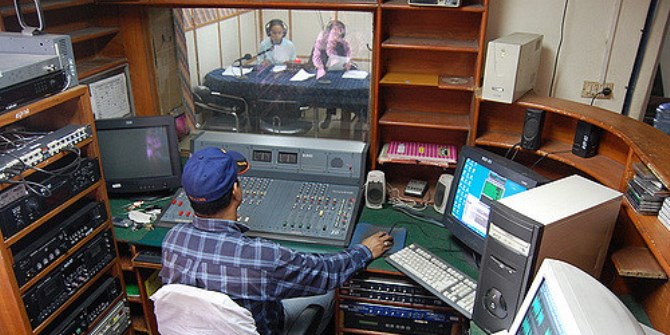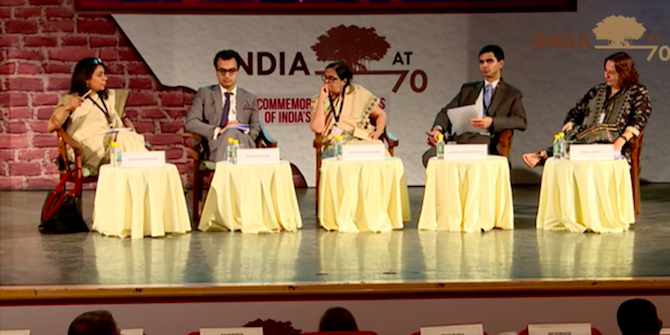 On 28 April 2016, UNDP Pakistan in collaboration with the LSE South Asia Centre held a talk at LSE to discuss a new report on the challenges and opportunities of Pakistan’s youth bulge. The speakers, Marc-André Franche, the Country Director of the UNDP Pakistan, and Emrys Schoemaker, Communications & Conflict Specialist and a PhD candidate at LSE, drew on their expertise to ignite a conversation about the critical role of youth engagement as a strategy to improve human development and peace in Pakistan. The talk was chaired by Dr Mahvish Shami, Assistant Professor at the LSE’s Department of International Development. Dominykas Broga reports on the event.
On 28 April 2016, UNDP Pakistan in collaboration with the LSE South Asia Centre held a talk at LSE to discuss a new report on the challenges and opportunities of Pakistan’s youth bulge. The speakers, Marc-André Franche, the Country Director of the UNDP Pakistan, and Emrys Schoemaker, Communications & Conflict Specialist and a PhD candidate at LSE, drew on their expertise to ignite a conversation about the critical role of youth engagement as a strategy to improve human development and peace in Pakistan. The talk was chaired by Dr Mahvish Shami, Assistant Professor at the LSE’s Department of International Development. Dominykas Broga reports on the event.

Leveraging on the findings of the UNDP’s new National Human Development Report (NHDR), Marc-André Franche opened the discussion by painting a delicate picture of Pakistan’s ‘youth bulge’.
Pakistan’s population is extremely young. Almost 64 percent of its 182 million population is currently below the age of 30, and the numbers of young people will continue to grow until 2035. The right policies could enable youth to become the driving force for Pakistan’s prosperity. However, according to Marc-André Franche, the government has not yet capitalised on its ‘demographic dividend’.
What is more, Pakistan only has a limited window of opportunity to leverage on its shifting age structure – the opportunity that may not come again for many generations. From 2035, the NHDR predicts that the population is posed to age twice faster than many Western countries. If the right strategies and policies are not put in place to meaningfully engage youth in their communities, deliver quality education and secure future livelihoods today, the group forming the biggest workforce in Pakistan’s history is at risk of becoming marginalised, intolerant, vulnerable to joining violent groups, and unable to contribute towards the economy or broader development of the country.
Marc-André Franche suggested that the quality of addressing the needs and aspirations of young people today “will define the common future of Pakistan – whether it grows and thrives or fails and implodes.”
Turning the discussion towards the specific opportunities and challenges for youth engagement, Franche explored three key areas where the effective policies, investments and strategies can transform the growing numbers of young people from a liability to problem-solving producers, creators, entrepreneurs, and community leaders of the coming decades: education, employment and engagement.
Education: The way to achieve quantity is through quality
According to Franche, even though education has certainly received attention from the government, the current policies are insufficient to achieve the necessary change. Today, 26 million kids are out of school, and if Pakistan is to continue with the present agenda on education, even with the accelerated support for school enrollment, it will take until 2076 to achieve full enrollment rates – a timeline which is completely insufficient to benefit from a youth dividend.
While the current policy on education places great emphasis on quantity – building more schools, hiring more teachers – the findings of the UNDP Report show that what drives quantity is actually quality.
“Parents are not sending their kids to school not because they don’t think education is important, but because they know that sending their kids to a bad school will not amount to anything,” said Franche citing the results of the UNDP research.
Similarly, he identified that approximately 76 percent of kids in Balochistan cannot do a simple two digit division. Equally shocking are the results found in higher education and vocational skills training: university graduates are experiencing high unemployment rates and there is only a 35% employment rate among vocational training pupils.
Franche argued that the skills which kids learn are often not marketable and as a result education is not having its intended effect i.e. to reduce inequalities and integrate young people into a productive workforce. Not only has this created a crisis of expectation, but it is also leading to a generation of young people who are prone to frustration, division and violence. Franche therefore sees the challenge of quality across education system as an avenue of intervention: “Quality of education is much more important than quantity for solutions to youth engagement.”
Employment: Promoting entrepreneurship
The second critical area for youth engagement, according to Franche, is employment. Every year, 4 million youths enter the job market and additional 1.5 million jobs need to be created each year until 2040 just to address the demand. On top of that, Pakistan is already facing the highest unemployment rate in the past 25 years, especially among young people, meaning that its job market actually needs to grow even faster. Furthermore, over 60 percent of young people are currently in unstable or low paid jobs, and 35 percent of those that do have a job are working in an unpaid position. This creates a tremendous aspirational crisis Franche argued, which, if left unchecked, could lead to a failure of the youth bulge.
A solution that Franche envisions is the encouragement and support of entrepreneurs who can lead the process of job creation themselves. However, it is currently very difficult for young people to access credit. 95 percent of the loan system has been absorbed by the government and there are few incentives for banks to support small enterprises. Franche proposed the relaxation of the barriers to entrepreneurship as a strategy for harnessing the youth bulge.
Engagement: Avenues for social and political interaction
Finally, Marc-André Franche suggested avenues for social and political interaction were key to maximising the demographic dividend. Over the years, Pakistan has seen a dramatic shrinking of the public spaces together with opportunities for youths to meet and engage with different people. According to the UNDP findings, 60 percent have never been to another province and 90 percent have never had access to sports facilities. In addition, 75 percent of young people did not approve of the non-Muslims’ right to preach their faith. Franche argued that the lack of exposure to individuals outside of their community have led many young people to subscribe to an increasingly divisive and intolerant discourse. To combat this, he proposed to focus on improved access to basic facilities as a way to foster youth engagement in their communities and provide effective means for reducing intolerance.
Similarly, political engagement remains a challenge and avenue for engagement. UNDP’s survey indicated a clear sign of mistrust of politics among young people with only 24 percent expressing any trust in politicians. That said, young people remain politically active with 4 out of 5 young people having voted in the last election and over 60 percent intending to do so again. According to Franche, the results indicate that young people do indeed aspire to become active participants of the political process and communities but do lack formal avenues to do so. His proposition was to increase community centres, like a successful example of Dera Ismail Khan, where communities can gather, learn, engage with government representatives and participate in positive recreation such as sports and cultural activities.
Technology: An avenue for advancing youth engagement?
Emrys Schoemaker moved the discussion to talk about the ways how technology and social media can transform peoples’ lives. Drawing on his extensive ethnographic research, Schoemaker illustrated how technology can enable youth engagement but also how it can be used as a tool for separation, perpetuation of sectarianism and the reproduction of physical boundaries in digital spaces.
According to Schoemaker, the narrative of development through technology often sees access to mobile phones, internet, and other information technologies, as directly linked to empowerment and liberation. However, by using examples from his research in Mandi Bahauddin, Schoemaker illustrated how young Pakistanis have often used technology to maintain the existing cultural norms and traditions, perpetuate digital divides and increase sectarianism. Emrys Schoemaker suggested that technology can undoubtedly play a positive role in encouraging youth engagement. However, similarly to the issue of education, the policies on technological access should take into consideration the interplay between technological designs, identities and local traditions in order to understand the effects that technology will have on society.
Both speakers agreed that the “economic miracle” experienced by some of the East Asian economies could become a reality for Pakistan. However, the success depends largely on how well the government responds to young peoples’ needs today and leverages these opportunities in productive ways.
Note: This article gives the views of the author, and not the position of the South Asia @ LSE blog, nor of the London School of Economics. Please read our comments policy before posting.
About the Author
 Dominykas Broga is a research manager at the research and advisory service, iguacu Ltd. Prior to joining iguacu Ltd., Dominykas worked on projects ranging from public relations to advocacy and research on contentious politics. As an avid fan of geopolitics, he has written extensively on frontier and emerging markets. His analyses have been quoted in Wall Street Journal, Financial Sense, Swedish Institute for European Policy Studies and Myanmar Business Today, among others. Dominykas is an LSE alumni, where he studied MSc. Conflict Studies.
Dominykas Broga is a research manager at the research and advisory service, iguacu Ltd. Prior to joining iguacu Ltd., Dominykas worked on projects ranging from public relations to advocacy and research on contentious politics. As an avid fan of geopolitics, he has written extensively on frontier and emerging markets. His analyses have been quoted in Wall Street Journal, Financial Sense, Swedish Institute for European Policy Studies and Myanmar Business Today, among others. Dominykas is an LSE alumni, where he studied MSc. Conflict Studies.








Very good analysis, but it will be redundant if no institution takes initiative to mitigate situation. Depending on Government of Pakistan will be a day dream.
Hi Ali, thanks for your comment. I do agree with you. Other institutions and grassroots entities should undoubtedly be part of the solution. These challenges concern the society at large and the broad engagement is key to success. UNDP, together with partners, have recognised this and has been involved in activities to engage various parts of Pakistan society (and international partners) to gain the momentum on youth issues.